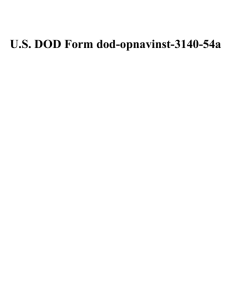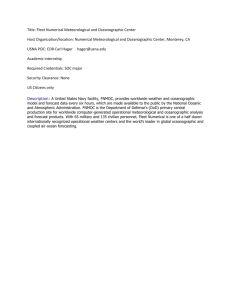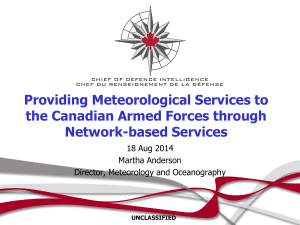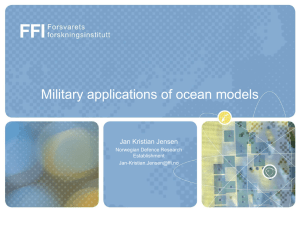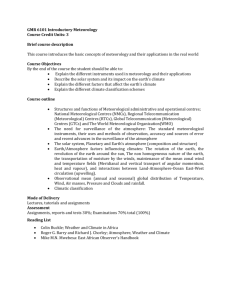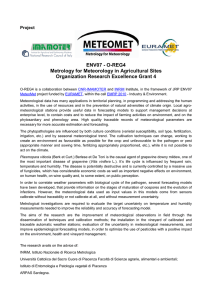ADMINISTRATION AND TRAINING CHAPTER 14
advertisement
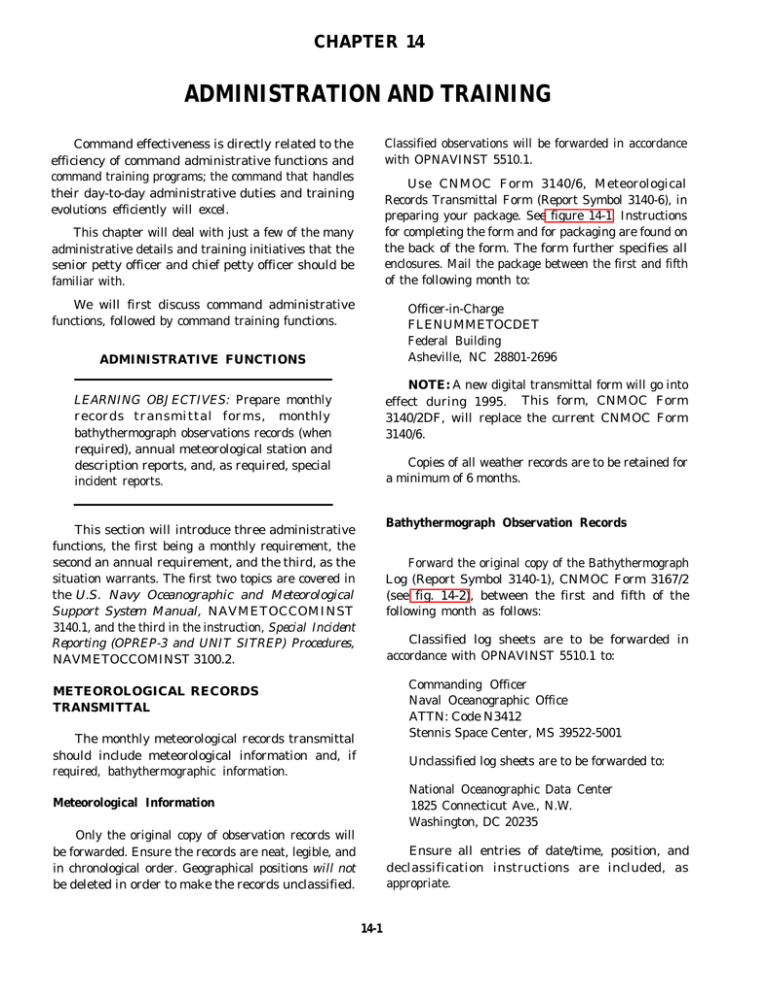
CHAPTER 14 ADMINISTRATION AND TRAINING Classified observations will be forwarded in accordance with OPNAVINST 5510.1. Command effectiveness is directly related to the efficiency of command administrative functions and command training programs; the command that handles their day-to-day administrative duties and training evolutions efficiently will excel. Use CNMOC Form 3140/6, Meteorological Records Transmittal Form (Report Symbol 3140-6), in preparing your package. See figure 14-1. Instructions for completing the form and for packaging are found on the back of the form. The form further specifies all enclosures. Mail the package between the first and fifth of the following month to: This chapter will deal with just a few of the many administrative details and training initiatives that the senior petty officer and chief petty officer should be familiar with. We will first discuss command administrative functions, followed by command training functions. Officer-in-Charge FLENUMMETOCDET Federal Building Asheville, NC 28801-2696 ADMINISTRATIVE FUNCTIONS NOTE: A new digital transmittal form will go into effect during 1995. This form, CNMOC Form 3140/2DF, will replace the current CNMOC Form 3140/6. LEARNING OBJECTIVES: Prepare monthly records transmittal forms, monthly bathythermograph observations records (when required), annual meteorological station and description reports, and, as required, special incident reports. Copies of all weather records are to be retained for a minimum of 6 months. Bathythermograph Observation Records This section will introduce three administrative functions, the first being a monthly requirement, the second an annual requirement, and the third, as the situation warrants. The first two topics are covered in the U.S. Navy Oceanographic and Meteorological Support System Manual, NAVMETOCCOMINST 3140.1, and the third in the instruction, Special Incident Reporting (OPREP-3 and UNIT SITREP) Procedures, NAVMETOCCOMINST 3100.2. Forward the original copy of the Bathythermograph Log (Report Symbol 3140-1), CNMOC Form 3167/2 (see fig. 14-2), between the first and fifth of the following month as follows: Classified log sheets are to be forwarded in accordance with OPNAVINST 5510.1 to: Commanding Officer Naval Oceanographic Office ATTN: Code N3412 Stennis Space Center, MS 39522-5001 METEOROLOGICAL RECORDS TRANSMITTAL The monthly meteorological records transmittal should include meteorological information and, if required, bathythermographic information. Unclassified log sheets are to be forwarded to: National Oceanographic Data Center 1825 Connecticut Ave., N.W. Washington, DC 20235 Meteorological Information Only the original copy of observation records will be forwarded. Ensure the records are neat, legible, and in chronological order. Geographical positions will not be deleted in order to make the records unclassified. Ensure all entries of date/time, position, and declassification instructions are included, as appropriate. 14-1 Figure 14-1.-CNMOC Form 3140/6, Meteorological Records Transmittal Form. 14-2 Figure 14-2 14-3 Figure 14-3.-CNMOC Form 3140/5, Meteorological Station and Description Report. 14-4 dependent on correct documentation describing instruments and sensors, exposures, location, height above the ground, orographic features surrounding the station, and other pertinent remarks regarding sensor performance. Instructions for completing the form and for mailing are found on the form. METEOROLOGICAL STATION AND DESCRIPTION REPORT All METOC units will prepare the Meteorological Station and Description Report, CNMOC Form 3140/5 (Report Symbol 3140-7). See figure 14-3. Instructions are found on the back of the form. The report is to be mailed annually by the 25th of January, or anytime unit instrumentation, or its location, is changed The report reflects current station instrumentation as of 1 January of the year submitted. Along with paper copies of upper air soundings, digital sounding data on floppy diskettes are to be submitted to FLENUMMETOC DET Asheville as well. The entire sounding is needed during downloading to floppy diskette, including the “load sonde” program (the header page), the environmental data, and the TEMP, and LIST outputs. Be sure to write prefect the disk. NOTE: CNMOC Form 3140/5 will be replaced by a new digital form CNMOC Form 3140/1 DF, Station Information File, during 1995. SPECIAL INCIDENT REPORTING (OPREP-3 AND UNIT SITREP) PROCEDURES Anew form, CNMOC Form 3140/3DF, Upper Air Termination Log, will also go into effect during 1995 (figure 14-4). This form will be used to track termination heights that are used in compilation of monthly and semiannual station quality control reports. The instruction, Special Incident Reporting (OPREP-3 and UNIT SITREP) Procedures, COMNAVMETOCCOMINST 3100.2, requires that all METOC units file an OPREP-3 or UNIT SITREP as The accuracy of studies derived from environmental observations are, to a large extent, Figure 14-4.-CNMOC Form 3140/3DF, Upper Air Termination Log. 14-5 appropriate in the event of special incidents that may attract national and/or high-level U.S. Navy interest, and in addition, other incidents that are of interest to the Commander, Naval Meteorology and Oceanography Command (CNMOC). Mission Impairment Incidents impairing mission performance are reported as a Unit Situation Report (UNIT SITEEP) in the format of CNMOC 3100.2, while certain weather-related incidents are reported in accordance with enclosure (1) of the instruction (UNIT SITREP Weather-Related Accidents/Incidents). COMNAVMETOCCOM interest is in incidents causing significant and extended mission impairment that is not adequately covered by the CASREP System. INSTRUMENT GROUND SCHOOL All METOCCENs, METOCFACs, and METOCDETs with aviation units are required to annually conduct Instrument Ground School for all naval aviators and naval flight officers. Instruction, at a minimum, should include meteorological parameters, pilot reporting procedures, code formats, briefing forms, OPARS forms and procedures, NATOPS requirements, and severe weather warnings. For further discussion of minimum content of Instrument Ground School, refer to the instruction, NATOPS General Flight and Operating Instructions, OPNAVINST 3710.7, chapter 13. Weather-Related Accidents/Incidents We will now briefly discuss required actions in the event of weather-related accidents/incidents. LOCAL AREA FORECASTER HANDBOOKS One of the first publications that all newly reporting forecasters should review upon reporting to a new command is the Local Area Forecaster’s Handbook. These handbooks are an invaluable source in anticipating local meteorological and oceanographic phenomena. PURPOSE.— To notify the chain of command of weather-related/high seas accidents/incidents involving ships, aircraft, personnel, facilities, or other resources that may generate press interest, or become the subject of formal inquiries. REPORTING CRITERIA.— required when accidents/incidents or potentially so. Reports are accident/incidents are clearly not In the following sections we will discuss the training functions for which the METOCs are responsible. A UNIT SITREP is are weather-related not desired when weather-related. The instruction, Local Area and Area of Responsibility (AOR) Forecaster’s Handbooks, NAVMETOCCOMINST 3140.2, states the requirements for maintenance of Forecaster’s Handbooks and basic guidance on their form and content. For amplifying instructions for the proper procedures for submitting accurate and timely OPREP-3’S and UNITS SITREPs, refer to CNMOC 3100.2, as well as the instruction, Special lncident Reporting, OPNAVINST 3100.6. There is a continuing need to update Forecaster’s Handbooks. Each command should have a program in place that continually verifies local thumb rules, as well as a program to develop new forecasting techniques. For this reason, all Forecaster’s Handbooks are to be reviewed and updated at least annually. The remaining portions of this chapter will deal with training functions associated with all METOC activities. TRAINING FUNCTIONS The Naval Oceanographic Office is now in the process of assembling and publishing a compendium of all Forecaster’s Handbooks developed by NAVMETOCCOM and USMC activities in compact disc-read only memory (CD-ROM). Describe LEARNING OBJECTIVES: instrument ground school training for naval aviators and naval flight officers. Explain the requirement to update command local area forecaster handbooks. Review the U.S. Navy Oceanographic and Meteorological Support System Manual, METOC technical bulletins, METOC OPORDs, and climatology publications for possible data inclusion in pre-deployment briefings. For further discussion of the need and content of the Forecaster’s Handbooks, refer to NAVMETOCCOMINST 3140.2. The forecaster will find there are a multitude of details involved in the planning and execution of underway evolutions, as well as in the everyday operation of METGCCOM activities. In the following 14-6 In planning for a future exercise, it helps to glean information from previous deployments. The next section will deal with this subject. section we will discuss various sources of information, and factors to be considered and acted upon. PUBLICATION REVIEW METEOROLOGICAL AND OCEANOGRAPHIC (METOC) POST-DEPLOYMENT REPORTS When preparing for operations or exercises the forecaster should review all available METOC publications to assess the environmental impact on the area of interest. The instruction, Oceanographic Post Deployment Reports, NAVMETOCCOMINST 3140.23, requires a post-deployment report be prepared to describe meteorological and oceanographic conditions encountered (and quality of support received) after a major deployment by ships with permanently assigned METOC personnel. Review of the U.S. Navy Oceanographic and Meteorological Support System Manual, NAVMETOCCOMINST 3140.1 It is a good practice to review the U.S. Navy Oceanographic and Meteorological Support System Manual at the earliest time prior to any operation or exercise, if for no other reason, to jog your memory for potential sources of support. Content At a minimum, METOC post-deployment reports should contain an overview of the following: Environmental support received Review of METOC Technical Bulletins Unique METOC conditions experienced COMNAVMETOCCOM, NAVOCEANO, and the National Weather Service to name just a few commands and organizations, promulgate on a nonroutine basis bulletins that may be of benefit in the planning and execution of operations. It is incumbent on the forecaster to review these bulletins and publications for possible application in upcoming operations. Services provided to other units Problems encountered Any new procedures attempted Enclosure (1) to NAVMETOCCOMINST3140.23 provides an outline to be followed in preparing the report. A daily log will ease preparation of the report. Review of METOC OPORDs Discussion It is critical that the OA division be involved at the earliest in the drafting, planning, and execution of exercise OPORDs. Weather guard assignments, planned intended movements (PIMs), and required METOC services are just a few of many considerations that will be covered in the OPTASK METOC section of an OPORD. Meteorological and The instruction, Oceanographic Post-Deployment Reports, NAVMETOCCOMINST 3140.23, has been coordinated with Commander-in-Chief, Pacific Fleet (CINCPACFLT), Commander-in-Chief, Atlantic Fleet (CINCLANTFLT), and Commander-in-Chief, U.S. Navy, Europe (CINCUSNAVEUR). Review of Climatology CLASSIFICATION.— Normally, METOC postdeployment reports are unclassified. However, if necessary, a confidential enclosure may be included. Secret enclosures are discouraged, but may be included if deemed germane. As discussed earlier in this manual, climatology plays a critical role in operational planning. The various players will want to know at the earliest opportunity what type of weather conditions can be expected. Chapters 10 and 13 of this text deal with climatology and its various sources. The U.S. Navy Oceanographic and Meteorological Support System Manual, NAVMETOCCOMINST 3140.1, contains a chapter on climatology support services for planning and research. TIMELINESS.— Post-deployment reports should be submitted via the ship’s commanding officer within 6 weeks of the end of the deployment. In this day of regular introduction of new and more sophisticated METOC equipage, platform sensors, and 14-7 weapon’s systems, it becomes more and more crucial that our personnel receive top-notch training. In the following section we will discuss the Naval Meteorology and Oceanography Command Training Program. THE COMMAND TRAINING AND CERTIFICATION PROGRAM l Establish a Planning Board for Training (PBFT). l Establish and maintain both short- and long-range training programs. l Maintain current training folders for each enlisted member, and ensure prompt entries are made. l Conspicuously post and update Personnel Qualification Standards (PQS) and training progress charts. LEARNING OBJECTIVES: Be familiar with the Naval Meteorology and Oceanography Command Training and Certification Program, as well as the instructions guiding the technical inspections of afloat units. l Ensure that general military training (GMT) is implemented. l Establish and maintain a PQS program in accordance with current instructions and directives. The instruction, Naval Meteorology and Oceanography Command Training and Certification Program, NAVMETOCCOMINST 1500.2, sets forth policy, assigns responsibility, and establishes procedures for the training and certification of Naval Meteorology and Oceanography command personnel. l Prepare job qualification requirements (JQRs) to augment PQS as necessary for site unique watchstation requirements, l Ensure and document certification for personnel who have completed JQRs and specified PQS requirements. APPLICABILITY l Provide leadership training incorporating NAVLEAD principles, NAVMETOCCOMINST 1500.2 is applicable to all officer and enlisted personnel assigned to NAVMETOCCOM activities, Marine Corps weather service activities, the Naval Meteorology and Oceanography Reserve Program, and civilian personnel assigned to NAVMETOCCOM activities providing meteorological and oceanographic services to the fleet. This instruction has the concurrence of the Commandant of the Marine Corps and the Commander, Naval Reserve Force. l Budget for, and send personnel to pertinent training on a temporary assigned duty (TAD) basis. Refer to NAVMETOCCOMINST 1500.2 for a detailed discussion of the requirements and command responsibilities of local training programs. TECHNICAL INSPECTIONS OF AFLOAT UNITS RESPONSIBILITIES The last topic to be discussed in this manual will be that of technical inspections of afloat units. Commanding officers, officers-in-charge, and chief petty officer/petty officer/staff noncommissioned officers-in-charge of all NAVMETOCCOM and Marine Corps weather service activities are responsible to perform the following: . Increase the military and professional knowledge of their personnel by developing and implementing local training programs, obtain training media, and use the available pipeline and service schools. We all cringe when the division officer passes the word that the weather office will be inspected. But if you consider the inspection as a learning and sharing experience, it won’t be quite so painful. The intent of these inspections is not to put your office on report, but to assist the office in identifying any shortcomings, if any, as well as to identify and acknowledge those areas in which the office excels. . Designate a training officer/petty officer to assist the executive officer or officer-in-charge in the administration of a training program. The responsibility for technical inspections of afloat units lies with the respective fleet commanders in chief in your AOR. 14-8 functions addressed were the monthly Meteorological including Records Transmittal Form, Bathythermograph Observation Records, when required. Facets of the annual Meteorological Station and Description Report were then discussed. The last topic discussed under administrative functions was that of Special Incident (OPREP-3 and UNIT SITREP) Procedures, with background information, purpose, and reporting criteria addressed. The remaining portion of this chapter dealt with command training functions. We discussed the intent and the requirement for Instrument Ground School. Next, was a discussion on the requirement for the preparation of local area forecaster’s handbooks and their value. We then presented various publications and documents that should be reviewed by METOC personnel prior to operations/exercises, including, the U.S. Navy Oceanographic and Meteorological Support System Manual, various METOC bulletins, OPORDs, and climatology publications. Finally, we discussed the Naval Meteorology and Oceanography Command training and certification program, and the technical inspections of afloat units. Applicability The respective fleet commanders in chief instructions regarding inspection of afloat units contain recommended inspection guide lists. These guide lists should be used by the inspecting officer to ensure standardization. Advance preparation of these guide lists by those units being inspected is not required, but an advance review of the areas will be of benefit to facilitate inspection of the units’ operation and administration. Action When requested by inspection authorities, COMNAVMETOCCOM will direct regional activities to provide METOC officers to serve as inspecting officers. SUMMARY In this chapter, we first discussed command administrative functions. Those administrative 14-9
